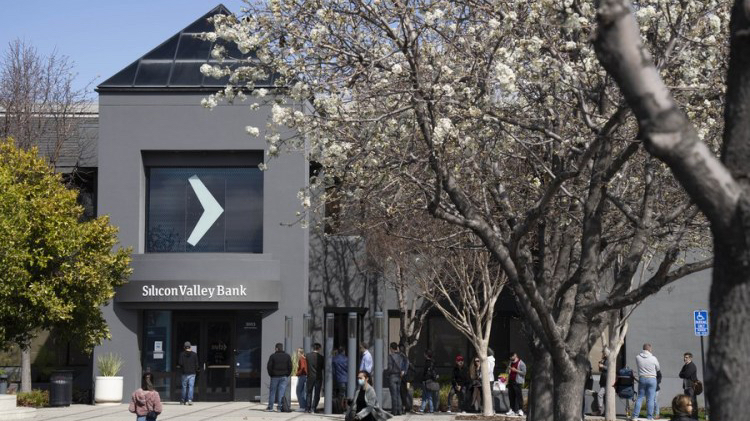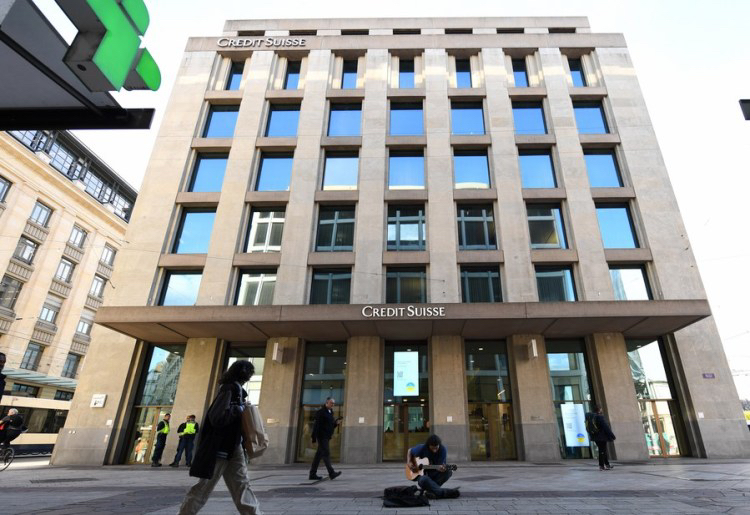
People queue up outside the headquarters of the Silicon Valley Bank (SVB) in Santa Clara, California, the United States, March 13, 2023. /Xinhua
People queue up outside the headquarters of the Silicon Valley Bank (SVB) in Santa Clara, California, the United States, March 13, 2023. /Xinhua
Editor's note: Daryl Guppy is an international financial technical analysis expert. He has provided weekly Shanghai Index analysis for mainland Chinese media for more than a decade. Guppy appears regularly on CNBC Asia and is known as "The Chart Man." He is a former national board member of the Australia China Business Council. The article reflects the author's opinions and not necessarily the views of CGTN.
The Silicon Valley Bank (SVB) collapsed rapidly because it did not have enough liquid funds to meet customer demands for withdrawals. It was a classic run on an individual bank and once it starts, panic spreads quickly, accelerated by social media.
Like a scary movie, it makes people nervous and they are ready to jump at the shadows. It exaggerates any other type of problem in any bank, as we have seen with Credit Suisse. The Swiss bank was already managing several problems which impacted its integrity. The rapid SVB collapse highlighted its banking problem. This is the contagion factor, and it's driven by the loss of faith in the system rather than actual weakness.
Interest rate hikes are part of the story of the SVB collapse because of the mismatch of low-interest assets and increasing interest rates. However, there were several other red flags in the bank's structure and dealings that should have given regulators cause for concern.
More broadly, the 2020 Federal government decision to reduce bank reserve requirements to zero is also a factor. This was parts of former U.S. President Donald Trump's response to COVID-19. It made little sense at the time and many analysts warned it would lead to exactly where we are now.
The decision meant that banks are not required to keep any amount of their assets in cash or liquid equivalents to be able to service requested withdrawals. This is one of the reasons that even a minor bank run could be a disaster at any U.S. bank. In this sense, U.S. banking remains part of the wild west with persistent bank failures.
This is the largest bank failure since the 2008 financial crisis. Therefore, it's reasonable to ask how the collapse of Silicon Valley Bank compares to the 2008 bailout, and will the 2008 financial crisis repeat.
The situation is different from 2008. That crisis was driven by a toxic derivative product, collateralized debt obligations (CDOs). The current situation is more related to macroeconomic policy and poor management by individual bankers. Solutions rest on monetary policy decisions.
The loose monetary policy chickens are coming home to roost. As rates rise, more banks will be knocked off the perch. It's not a systemic threat yet, but the ripple effects on confidence will stress the U.S. system and individual banks. BlackRock Chief Executive Larry Fink said "more seizures and shutdowns" of banks are possible after "decades of easy money."

A building of Credit Suisse, Switzerland's second-largest bank, is pictured in Geneva, Switzerland, October 3, 2022. /Xinhua
A building of Credit Suisse, Switzerland's second-largest bank, is pictured in Geneva, Switzerland, October 3, 2022. /Xinhua
The key canary in the coal mine is the willingness of other banks to come to the rescue as they did with bailouts in 2008. Smart investors are positioning themselves for a surge in M&A activity.
There are ripple effects on the U.S. banking ecosystem but we need to acknowledge that bank collapses are common in the U.S. More than 500 U.S. banks have failed since 2001. There is Federal government deposit protection for ordinary people although just how far that can be stretched is becoming an open question. The indirect or ripple impact comes for business loan leverage and the potential for business collapses.
The U.S. government stepped in to protect customer deposits in full. This begs the question: Are U.S. taxpayers on the hook for SVB deposits?
Taxpayers were well and truly hooked in 2008 for the government sponsored bailout. But currently, this situation does not have the characteristics of 2008. It is inevitable that tightening monetary policy with interest rate hikes will strangle the weak banks in the sector but the hope is that other banks, not taxpayers, will buy them out. It's the U.S.-style of destructive capitalism in action and collateral damage is part and parcel of any mitigation strategy.
Silicon Valley Bank specialized in banking for tech startups, providing financing for almost half of U.S. venture-backed technology and healthcare companies. This is the broader impact of the collapse. It means start-ups will need to refinance and that becomes more expensive as interest rates rise. We can expect to see many unlisted startups collapse as funding dries up. There will be some flow-through impact on the Nasdaq so the downtrend that started in 2022 will continue.
The factors that led to the SVB collapse are unique to the United States, although bad management can be found in any country. The systemic factors contributing to global unease are not found in the Chinese banking environment. Just like companies in the U.S. banking sector, the tech sector is very much a matter of managing individual company risk rather than systemic risk. Although some banks may become sick, they are not contagious.
(If you want to contribute and have specific expertise, please contact us at opinions@cgtn.com. Follow @thouse_opinions on Twitter to discover the latest commentaries in the CGTN Opinion Section.)